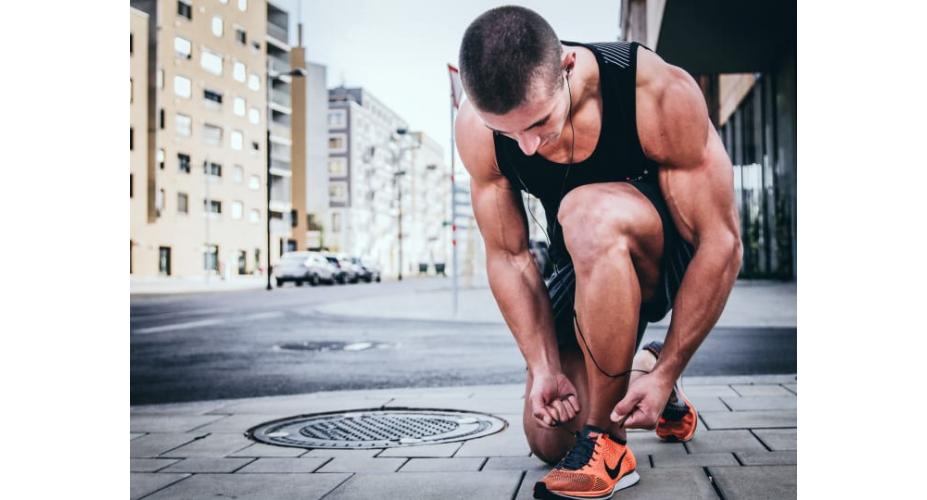
How you lace up your shoes can make all the difference in comfort and performance.
We spend a lot of time researching the proper shoes for our sport — whether it be running, CrossFit or strength training — making sure that they fit just so and that they provide optimal support and perform well during activity. But once afoot, your shoes are only good if they are comfortable, and how you lace them up can make or break your workout experience.
How you lace your shoes can make or break your workout experience.
"Common problems with shoe dysfunction during training can often be fixed with simple changes to lacing," says Jason Havey, DPM, chief resident of podiatric surgery at Hennepin County Medical Center in Minneapolis. And while the tightness of a shoe is often a matter of preference, the general rule of thumb, according to Havey, is that a shoe should be "comfortably snug": Your foot should not be able to move around, but there also should not be any discomfort.
Here are some common issues you might encounter with your footwear and the lacing techniques to resolve them.
. Oxygen Magazine/Toe-box relief lacing
ISSUE: Black toenails or Morton's toe
Some runners claim that unless you have black toenails, you're not legit. Truth be told, disgusting, dead nails are not a badge of honor. "If your shoes are too tight or narrow, your toes will hit the front of the shoe with every step, leading to toenail problems," Havey says. Also, people whose second toe is genetically longer than the others — called Morton's toe — can have the same issues with their toes continually striking the front of the toe box. Use this lacing technique to lift the toe box, creating room and preventing the shoe from pressing down on your nails and toes.
SOLUTION: Toe-box relief lacing
Completely remove the lace from the shoe. Thread one end down through the eyelet on the side nearest your big toe, then bring it diagonally up and across, pulling it up through the top eyelet on the opposite side. Leave enough lace so that you can progressively weave the other end back and forth up to the top of the shoe.
 .
.
Oxygen Magazine / Pressure-relief lacing
ISSUE: Hot spots, numbness and/or tingling on top of the foot
The last thing you want to have happen during a race or workout is to have your feet fall asleep or get a blister where your shoe rubs or presses down on your foot. "High-arched individuals or those with a high instep are prone to nerve irritation across the top of the foot," Havey says. "The downward pressure of the laces on the bones of the midfoot can irritate the nerves in the area." Use this technique to relieve this top-heavy pressure and prevent irritation of nerves and/or skin.
SOLUTION: Pressure-relief lacing
Identify where you're feeling the pressure or where the shoe is rubbing, then unlace the shoe to a point just below that spot. Thread the laces vertically up the sides of the shoe, going as high as needed until you're above the hot spot, then resume your normal diagonal lacing to the top.

.Oxygen Magazine/Narrow-foot lock lacing
ISSUE: Shoes too loose/narrow feet
Just as it is difficult for those with wide feet to find a comfortably fitting shoe, so it is a challenge for those with narrow feet to get properly outfitted. "If your shoes are too loose, your foot may slide around inside, causing uncomfortable friction and blisters," says Havey, adding that you also could twist an ankle. This technique cinches up the shoe from bottom to top, keeping your foot in place to prevent injuries.
SOLUTION: Narrow-foot lock lacing
Thread your laces as you would normally through the first and second eyelets. Then thread the laces down through the next eyelets up on the same side to create a lock. Now cross the laces back over and weave them under the lock. Continue this lace-lock pattern all the way to the top of the shoe.

Oxygen Magazine/Lock lacing
ISSUE: Heel slippage
If you've ever wondered what that "extra" eyelet at the top of your shoe is for, you're about to find out: "Use the eyelets closest to your ankle joint to stop your heel from slipping or lifting," Havey says. This usually occurs if you have narrow ankles or heels or if your shoe is a little too big. Slippage can lead to blisters, hot spots or even a twisted ankle, so use this lacing technique to secure your heel into place.
SOLUTION: Lock lacing
Lace your shoe as you would normally all the way to the top. Then thread the laces down through those "extra" eyelets closest to your ankles and pull them through until there is a small loop remaining. Cross the laces over and through the loops on opposite sides and pull to tighten and lock down.
Oxygen Magazine/Wide-foot lacing
ISSUE: Wide forefoot or pinched toes
Having a wide forefoot can spell a tight squeeze with many shoe brands, even if they are designed for wider appendages. This can mean undue pressure and blisters on your big and/or pinkie toes or a pinching together of your toes, which can lead to impingement over time. This lacing technique releases some of the tension across the front of the shoe, creating more space for your foot to spread out.
SOLUTION: Wide-foot lacing
Thread the laces down through the first eyelets on either side, up through the second eyelets on the same side, then down through the third eyelets on the same side. Now lace diagonally as you would normally to the top.
Written by Lara McGlashan for Oxygen Magazine and legally licensed through the Matcha publisher network. Please direct all licensing questions to legal@getmatcha.com.



